Although massed start events had been supported by club members pre-war, with Ernie Mills finishing fourth in the Commonwealth Games RR of 1938 and 2nd in a 10 mile event in Bombay en route home from Australia, the first Addiscombe win is thought to be by Bill Boynton in 1943 at Victoria Park, Bath. Following World War 2 all NCU events were still being held on closed circuits like Finsbury Park and Crystal Palace, or disused wartime airfields such as Stapleford Tawney, Dunmow and Matching Green proving popular venues near London. Don Stone was achieving some success and Fred Spittles was another strong rider, not only at hillclimbing. He took a 2nd placing in 1950 and was placed 10th in an International GP at Brands Hatch.
Mario Stratta was the massed start secretary in 1952 when Eric Hall commenced racing. Eric was persuaded to join him and Bill Boynton in a handicap event at Gosport. Bill, always a wiley character, somehow got himself into the first group away and was out in front for most of the race eventually finishing second. The three came back with the team race in the bag.
Shortly after Eric Hall was drafted into the Royal Air Force. With his knowledge of the French language his Squadron Leader took him to France on a couple of occasions to act as interpreter. These visits for military conferences were of 2-3 weeks duration. The RAF was always cycling-friendly with its own cycling club and Hall took his beloved Frejus racing bike along. He recounts he forged himself a racing licence as an Independent for the RAF C.A. and rode numerous local events where on occasions he found himself up against Van Steinbergen, Stablinski or Jean Bobet. Hall admits he never featured in the events but they were pleasurable experiences.
In 1953 Mario Stratta handed over duties to Mick Blake. The club’s massed start racing had been at a low ebb in recent months but encouraged by an extremely enthusiastic Blake the situation changed rapidly.
At the Isle of Wight Rally Alan Drury, riding in his first massed start, finished a creditable third in the one-lap event over 8.6 miles. In the two-lap event, Cyril Hinton placed 4th and with Mick Blake and Henry Barber they took the team award. Bill Titley, our only entrant in the high class 53 miles ‘Round the Island’ race finished 25th.
Mick Blake (pictured) then won a 48 miles race at Stapleford Tawney and backed by Bill Titley in third position and Cyril Hinton 18th, following two punctures that had necessitated changing machines twice, they took the team award. Mick Jasper, riding his first massed start, finished 7th in the second class event.
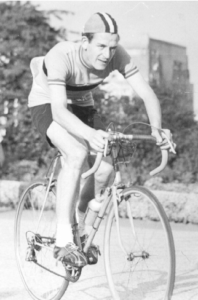
Bill Titley, backed by all the above mentioned, completed a good season and in a Novice race at Stapleford Tawney R. Nicholls and J. Potter finished a creditable equal 4th.
At this point it is necessary to revert to 1942 and the formation of the British League of Racing Cyclists (BLRC or “The League” as they became known). This organisation came into being because the National Cyclists Union flatly refused to consider road racing on the open road and in particular a race that a Wolverhampton cyclist, Percy Stallard, wanted to promote. With Police co-operation, Stallard went ahead with his promotion of the Llangollen-Wolverhampton Cycle Race (run in aid of the “Express and Star” Comforts Fund) and from that successful venture the British League of Racing Cyclists was eventually formed in November 1942. The National Cyclists Union and Road Time Trials Council retaliated by issuing a joint statement requesting clubs remove from membership any members who supported “the Rebel League”. Ron Baker, one of the “fast men”, was subsequently questioned and removed from membership. Baker, having made the break with the Addiscombe, went on to win a stage of the first stage race held in this country. In later years a number of NCU affiliated “massed start” riders quietly participated in League “road racing” events including members of the Addiscombe as shall be seen.
By 1953 the Addiscombe youngsters wanted to get into events run by “the League”. They tabled a motion at the AGM at the end of that season to affiliate to the BLRC, subject to ratification by the controlling Bodies. Two years later with the same motion still on the table it was finally thrown out and it was not until 1958 when the NCU, BLRC and RTTC came to a working agreement that the club members voted to affiliate.
In the interim the younger members solved the problem their own way. While remaining first claim to the Addiscombe where they continued to ride in NCU and RTTC events, at the same time they formed the Croydon Olympic and affiliated to the BLRC. Not recognised by the NCU or RTTC, members of this club could equally well have been in a tiddly-winks club and rode League events when and where they chose (perhaps not totally according to the rules!). Although the overall situation was still similar to that when Ron Baker had been “asked to resign” in 1943, there was a climate of change occurring that would see the NCU by 1953 being forced to permit some races on the road. This in turn hastened the eventual amalgamation of the NCU with the BLRC.
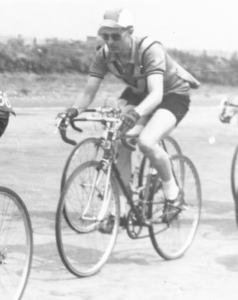
The ‘Croydon Olympic’ was formed in the backroom of the Addiscombe’s headquarters in Cross Road. Eric Hall* (pictured) took on the duties of secretary / treasurer and recalls the earliest members as Mick Blake, Robin Kingsland, Peter Moughton, John Gifford, Fred Burrage, Dave Olliffe, Ray Root and Peter White. They rode in events promoted by other like-minded clubs based on circuits round Chobham, Bury Hill, Crowborough Beacon and Crockham Hill. By 1958 it was suggested they too should contribute by putting on a promotion. Ernie Mills immediately offered his services as Clerk of the Course, Charlie Davey put up the prizes, and Addiscombe members generally rose to the occasion by providing the necessary support. The race was held on the Crockham Hill circuit but the result is lost in the mist of time.
Local League events were infrequent, and the boys rode Addiscombe colours in NCU events when it suited. This was not to the liking of some of the older fraternity in the club, but it was generally accepted as preferable to losing their membership altogether.
In the club’s officially recognised events promoted under NCU regulations, the 1954 season opened well for the club with Mick Jasper placing 3rd and Brian Nichols 8th in the 17.2 miles race on the Isle of Wight. At the Crystal Palace Whitsun Rally, Mick Blake won the senior race and in the junior event Brian Nicholls, Jack Willoughby and Ray Root finished second, sixth and seventh to take the team. Blake was unable to repeat his win of the previous year in the 48 miles race at Stapleford Tawney but finished a creditable 3rd. Riding in “the Onchan Cup”, a prestigious 40 miles race held during Isle of Man week, Mick Jasper finished well up in thirteenth position against a strong field.
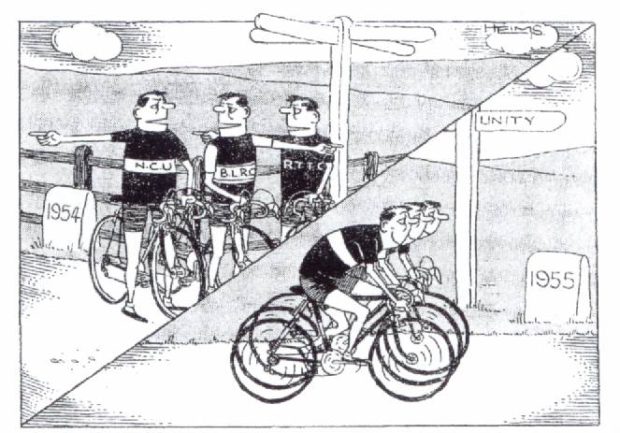
On the national situation, a tripartite agreement that had been drawn up earlier between the three Bodies (NCU, BLRC and RTTC) had failed. The position clearly could not continue and by the end of 1954, the Bodies were at least again ‘talking’ though it would take another three years before the matter was fully resolved.
Many of “the younger lads” were being called away on National Service though reading the Gazettes of that period it was not necessarily the end of their cycling. Dick Wiseman was racing in Germany, Ron Pitt winning road races in Egypt and Bill Edwards riding for REME. Back home Dave Olliffe was a junior showing great promise with a win at Stapleford Tawney in 1955 and later in the season, a team win with Eric Hall and John Gifford in a 50 miles event. Olliffe also won a 50 miles Handicap race and repeated his Stapleford Tawney win again in 1956 Peter Moughton finished 3rd in a 40 miles Whitsun event at Finsbury Park and improved on this a few weeks later when he won a 29 miles event on the same circuit. In 1956, Moughton also won no less than four BLRC events while riding in the colours of Croydon Olympic and was frequently joined by others.
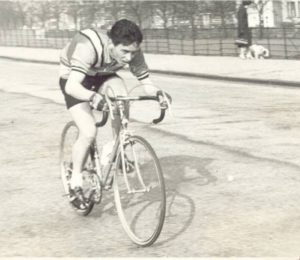
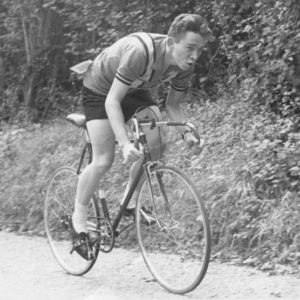
Both Olliffe and Moughton (pictured) are seen in Croydon Olympic vests as designed by Robin Kingsland.
In 1956 as a member of the Women’s Cycling Racing Association team she was selected to ride in the first Women’s International event to be staged in Britain. The event formed part of the Harrogate Festival but Grist was unlucky to be brought down by a pile-up and a damaged gear ended her race. She relates it was back to the station for the first train home.
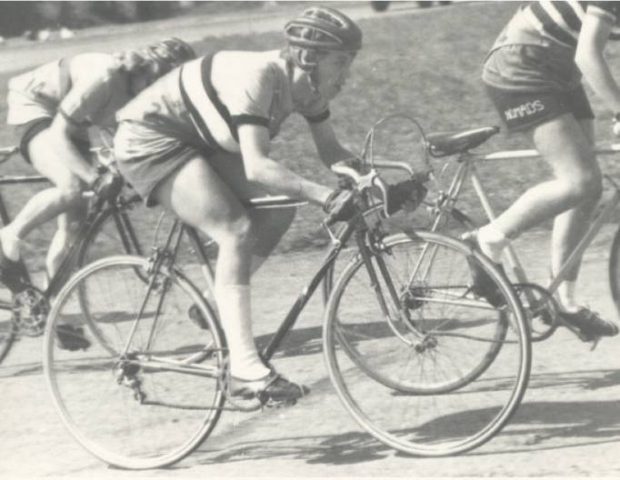
For massed start riders the year of 1957 started with yet more complications. The NCU and BLRC were still sorting out their differences. The NCU was permitting some 1st category amateur races to be open to “Independents”. The latter category was for one who did not rely on bicycle racing for a living, was permitted to accept money prizes, but was not qualified to revert to amateur status. Few moved up to become fully professional and eventually the rules had to be changed to allow Independents to revert to amateur status. RTTC regulations forbade any such integration of amateurs and independents. This caused a major problem to the 1st category massed start rider who wanted to ride a time trial but had competed against an Independent!
Massed start secretary Eric Hall recorded in the monthly Gazette, “a motley crew” spent an enjoyable Easter on the Isle of Wight. Part of the “cycling weekend” took the form of jiving on the promenade at midnight to music from the ‘34 Nomads hand-wound gramophone and sunbathing by day. The gramophone was the property of Don Stone and was conveyed in the basket of a tradesman’s bicycle! In between socialising Robin Kingsland finished a creditable 7th in “the Clubman’s Special” 57 miles road race. Eric Hall and others were delayed by an incident with a car, and on chasing the field came upon Peter White who had punctured. Eric stopped to assist his clubmate, only to see his wheel being whipped from his machine and Peter disappearing up the road! The following day in the first circuit race Kingsland and Wiseman finished well up with Gifford and Fred Burrage not far behind. White and Hall packed (another late night perhaps) and Don Robertson managed to fold his wheel up.
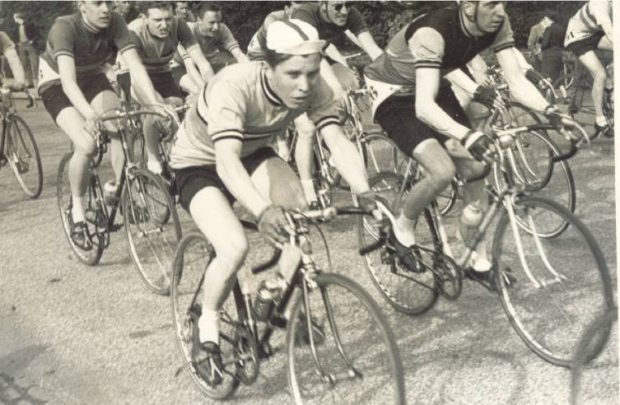
In the second race of the day Ron Aldridge crashed but still finished 25th. Dave Olliffe and Peter Moughton were present, riding in a team for the Royal Army Service Corps. Just an insight into a typical Isle of Wight Easter weekend of that period.
A Junior District Championship of 1957, run off at Brands Hatch, saw John Gifford finish in 3rd position.
- An Introduction to our History
- The 1883 Addiscombe Cycling Club
- The 1906 Addiscombe Cycling Club
- An Historical Background to the Road Record Associations
- A Brief Historical Background to Cycling Time Trials
- The Club’s Revival, 1929 to 1939
- The Club in Wartime, 1940 to 1946
- The Post-War Years, 1947 to 1957
- Post-War Track and Roller Racing
- The Men in Post-War Time Trials
- The Women in Post-War Time Trials
- Post-War Closed Circuit and Road Racing
- An Influx of New Riders and the Passing of a Statesman, 1958 to 1964
- The Club Heads Towards its Golden Jubilee, 1965 to 1978
- Membership Declines, 1979 to 1987
- The Arrival of the Young Mountain Bikers, 1988 to 1994
- Another Period of Declining Membership, 1995 to 1999
- New Century and a New Look for the Addiscombe, 2000 to 2006





